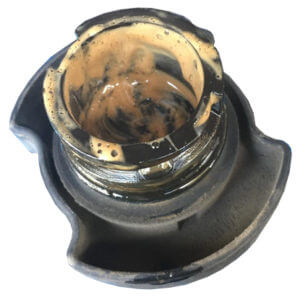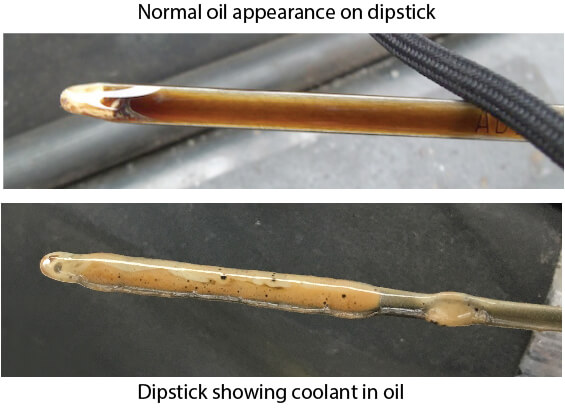What is the yellow gunk under your oil cap?
The yellow gunk under your oil cap doesn’t automatically mean you have a bad head gasket
If you’ve noticed yellow gunk in your oil fill cap, you might be concerned, but rest assured—it’s usually not a sign of something major like a head gasket failure. As an experienced auto tech, I can tell you that the appearance of a milky, yellowish deposit inside the oil fill cap is actually quite common, especially during colder months or if your vehicle is driven mostly short distances. What you’re looking at is called oil emulsion condensation.
If the oil on your dipstick looks normal, you don’t have a bad head gasket. That yellow or milky sludge deposit in the oil fill cap is just oil emulsion condensation.

Yellow gunk under the oil cap
In a Nutshell (if you don’t want to read the entire article)
Moisture is a natural byproduct of the combustion process. Some of it bypasses the piston rings and gets into the crankcase, where it mixes with the oil mist that’s always present there.
Any time oil and water mix, you get an oil emulsion. Try pouring any type of kitchen oil and water into a blender and running it. You’ll get a slightly yellowish gel.
Emulsion Definition: An emulsion is a mixture of two or more liquids that usually don’t mix, like oil and water. The liquids are broken into tiny droplets that are suspended in the other liquid
When you turn off the engine, the hot emulsion rises to the top of the engine, where it condenses in the colder oil fill cap. Why the oil fill cap? Because it cools faster than the hot engine.
Depending on the color of your motor oil, the congealed substance can have a yellow appearance or a slightly brown coloration. This condensation happens more often in colder weather than in summer due to the extreme differences in the temperature of the hot oil emulsion versus the temperature of the oil fill cap.
Yellow Gunk: It’s A Common Winter Phenomenon
When you turn off the engine, the hot crankcase gases rise to the top of the engine. The oil fill cap cools faster than the engine, so the oil emulsion condenses in the cap. This results in the milky, yellow gunk you see.
Why Short Trips Lead to Yellow Gunk
So, why does this happen more in cold weather? It takes longer for your engine to reach full operating temperature in winter, especially if you take short trips. If you drive for only a few miles, the engine doesn’t run long to heat the oil high enough to evaporate off the moisture, leading to more oil emulsion and ultimately condensation in the oil fill cap.
Now, here’s where you need to pay attention: always check the dipstick first before you flip out about the yellow sludge in your oil fill cap. If the oil on the dipstick looks normal—golden brown or dark brown and at the proper level— you can rest assured that the yellow sludge is NOT a sign of an engine problem. That’s right, no head gasket failure. However, if the oil appears frothy, milky, or has a distinct chocolate milkshake-like appearance, that is a sign of coolant mixing with the oil, and you should get your engine checked immediately.

Normal oil on the dipstick and dipstick with oil and coolant
So what causes the oil emulsion yellow gunk?
Engines need a rich air/fuel mixture to start in cold weather. When the air/fuel mixture ignites, some of the gas and exhaust seeps past the piston rings and enters the crankcase. This is called blow-by, and every engine, even brand new ones, have blow-by.
Blow-by contains carbon monoxide, oxygen, unburned fuel, soot, and water. If you drive at least 5 miles in warm weather or 10 miles in cold weather, the engine heats up enough to evaporate off the water and fuel from the oil. That reduces the presence of water in the crankcase oil mist.
However, if you take short trips in cold weather, where the engine doesn’t heat up enough to evaporate off all the water, you’ll get this yellow gunk in the oil fill cap.
 You should not worry about gunk in the oil cap if there’s no matching color on the dipstick
You should not worry about gunk in the oil cap if there’s no matching color on the dipstick
The Simple Solution
As long as the dipstick oil looks normal and there’s no chocolate milkshake consistency, there’s no need to panic. To prevent yellow gunk from building up in the future, you should try to take your vehicle on longer trips so it can heat up fully. Short trips don’t allow the engine to burn off the moisture, so regular, longer drives or more frequent oil changes are key to avoiding the gunk buildup.
©, 2018 Rick Muscoplat
Posted on by Rick Muscoplat

